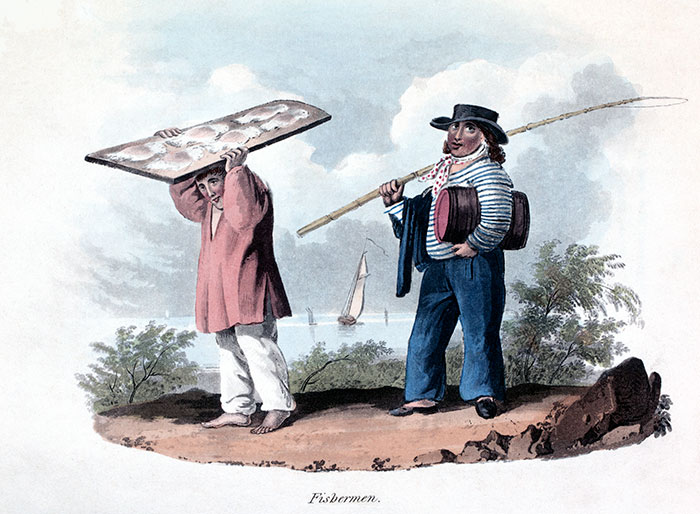engraving and text extracted from
History of Madeira - 1821 (from my library)
Madeira was then under British domination
Madeira fishing
The coast of Madeira is rich in the produce of its waters.
The abundance, variety, and excellence, of the fish, which are daily, nay, it may be said, almost hourly caught, is among the blessings with which the inhabitants of this island are favoured.
As the religion of the people is not only exclusively, but rigidly, Roman Catholic, their frequent abstinence from flesh meat as a religious rite, and the consequent application to fish, as the only allowable food on their numerous fast-days, and seasons of abstinence, renders the sea an essential reservoir of their sustenance.
The demand, therefore, is proportionally great, and the supply is fully, and at all times, equal to the demand.
The rivers are so rapid in their flow, and so interrupted by water-falls, that the eel appears alone to reward the labour of the interior fisherman.
Funchal has a regular fish-market, which is supplied, at least, three times a day ; and a few hours only intervene between the transfer of this necessary article of food from the sea to the table. This convenience arises, in a great measure, from the harbour being the scene of the fisherman’s labour, which is there so generally and so amply rewarded, that he is seldom known to extend his piscatory voyage beyond it.
Such it appears the sov’reign plan,
Nature the handmaid is of man.
Whate’er she’s given to produce
Is for his universal use :
Whate’er he wants she can supply
Or to his art or industry.
Nor is she bound by range of time,
By suns remote or varying clime ;
Each element her voice obeys,
And all combin’d her pleasure sways.
Nay, is it not by her command
That yellow harvests gild the land?
The silver wave, the briny flood,
The peopled air, the pregnant wood,
The pasture rich, the verdant plain,
All own alike her bounteous reign.
Has she not given to human toil
The nurtur’d fruits of ev’ry soil ?
E’en ’mid the Alpine Mountain’s snow,
Where torrents roar, and tempests blow,
E’en there her kindness will contrive
To make the native smile and live ;
Check in his breast each rude alarm,
And give the fur that keeps him warm.
But in this highly-favour’d isle
All plenty waits upon her smile ;
And adds the grape, that gives a zest,
By its rich juice, to all the rest.
The costumes:
In this engraving we see an angler whose clothes, hat, shoes, polka-dot scarf and barrel (of wine?) suggest that he is one of the wealthy inhabitants of the island.
The other figure, who is carrying a board with six fish that look like soles, is barefoot, wearing the classic white cotton trousers and a wide, plain-coloured blouse, typical of the island's manual workers at that time.
As they are walking along a dirt road in the interior of the island, we can assume that they are river fishermen.
... But in this case, they are eels that should be carried on the board.


![]()














